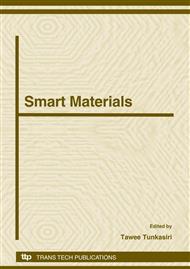p.61
p.65
p.69
p.73
p.77
p.81
p.85
p.89
p.93
Effect of Calcination Temperature on Phase and Morphology of Sol-Gel Derived PZTN Powders
Abstract:
Niobium doped PZT (PZTN) powder was prepared by a triol-sol-gel method from a mixture of lead (II) acetate trihydrate, 1,1,1-tris (hydroxymethyl), acetylacetone, titanium (IV) isopropoxide, zirconium (IV) propoxide and niobium (V) ethoxide and calcined at temperature ranging from 300-600oC for 2 h and 600oC for 4 h with a heating/cooling rate of 5oC/min. Thermal characteristics of the PZTN powders were studied using thermogravimetric/differential thermal analyses (TG/DTA). Phase formation in the powder was determined using X-ray diffraction analysis (XRD). Morphology of the PZTN powder was investigated by a scanning electron microscopy (SEM) and transmission electron microscopy (TEM). High purity perovskite structure of PZTN powder with a rhombohedral structure and a crystallite size 38 nm was obtained at the temperature of 600oC for 4 h dwell time. Well separated particles with uniform particle size distribution within 10-50 nm were also observed by TEM.
Info:
Periodical:
Pages:
77-80
Citation:
Online since:
August 2008
Keywords:
Price:
Сopyright:
© 2008 Trans Tech Publications Ltd. All Rights Reserved
Share:
Citation:


